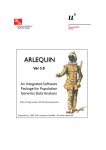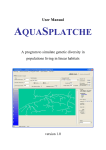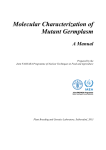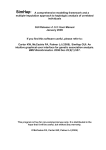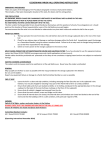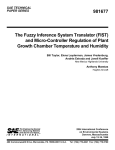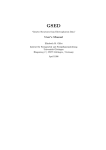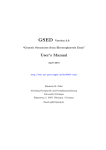Download Arlequin User Manual
Transcript
ver 1.1 Manual Arlequin ver 1.1 2 ARLEQUIN ver 1.1 A software for population genetic data analysis Authors: Stefan Schneider, Jean-Marc Kueffer, David Roessli, and Laurent Excoffier Genetics and Biometry Laboratory Dept. of Anthropology and Ecology University of Geneva CP 511 1211 Geneva 24 Switzerland E-mail : [email protected] URL: http://anthropologie.unige.ch/arlequin December 1997 Manual Arlequin ver 1.1 Table of contents 3 Table of contents: 1 Introduction 1.1 Why Arlequin? 1.2 Arlequin philosophy 1.3 About this manual 1.4 Data types handled by Arlequin 1.4.1 DNA sequences 1.4.2 RFLP Data 1.4.3 Microsatellite data 1.4.4 Standard data 1.4.5 Allele frequency data 1.5 Methods implemented in Arlequin 1.6 System requirements 1.7 Installing and uninstalling Arlequin 1.8 List of files included in the Arlequin package 1.9 Arlequin limitations 1.10 How to cite Arlequin 1.11 Acknowledgements 1.12 Bug report and comments 1.13 How to get the last version of the Arlequin software? 1.14 What is new in version 1.1 compared to version 1.0 1.15 Forthcoming developments 1.16 Remaining problem 6 6 6 6 7 8 8 8 8 9 9 10 10 11 12 12 12 12 12 13 13 14 2 Getting started 2.1 Preparing input files 2.2 Loading project files into Arlequin 2.3 Selecting analyses to be performed on your data 2.4 Creating and using Setting Files 2.5 Performing the analyses 2.6 Stopping the computations 2.7 Consulting the results 15 15 15 15 15 16 16 16 3 Input files 3.1 Format of Arlequin input files 3.2 Project file structure 3.2.1 Profile section 3.2.2 Data section 3.2.2.1 Haplotype list (optional) 3.2.2.2 Distance matrix (optional) 3.2.2.3 Samples 3.2.2.4 Genetic structure 3.3 Eexample of an input file 3.4 Automatically creating the outline of a project file 3.5 Conversion of data files 3.6 Arlequin batch files 17 17 17 17 19 19 20 21 23 24 25 26 27 4 Output files 4.1 Result file 28 28 Manual Arlequin ver 1.1 Table of contents 4.2 View your results in HTML browser 4.3 Arlequin Log file 4.4 Back-up file 4.5 Linkage Disequilibrium Result File 4.6 Variance components null distribution histograms 4 28 28 29 29 29 5 Examples of input files 5.1 Example of allele frequency data 5.2 Example of standard data (Genotypic data, unknown gametic phase, recessive alleles) 5.3 Example of DNA sequence data (Haplotypic) 5.4 Example of microsatellite data (Genotypic) 5.5 Example of RFLP data(Haplotypic) 5.6 Example of standard data (Genotypic data, known gametic phase) 30 30 30 31 32 33 34 6 Arlequin interface 6.1 Menus 6.1.1 File Menu 6.1.2 Edit Menu 6.1.3 Project Menu 6.1.4 Setup Menu 6.1.5 Special Menu 6.1.6 Window Menu 6.1.7 Help Menu 6.2 Toolbar 6.3 Status Bar 6.4 Dialog boxes 6.4.1 General Settings 6.4.2 Diversity indices 6.4.3 Neutrality tests 6.4.4 Gametic disequilibrium 6.4.5 Genetic structure 6.4.6 Launch Pad 35 35 35 35 35 37 37 37 38 38 39 39 39 41 43 44 46 48 7 Methodological outlines 7.1 Intra-population level methods 7.1.1 Standard diversity indices 7.1.1.1 Gene diversity 7.1.1.2 Number of usable loci 7.1.1.3 Number of polymorphic sites (S) 7.1.2 Molecular indices 7.1.2.1 Mean number of pairwise differences (π) 7.1.2.2 Nucleotide diversity or average gene diversity over L loci (RFLP and DNA data) 7.1.2.3 Theta estimators 7.1.2.3.1 Theta(Hom) 7.1.2.3.2 Theta(S) 7.1.2.3.3 Theta(k) 7.1.2.3.4 Theta( π ) 50 51 51 51 51 51 51 51 52 52 52 53 53 54 7.1.2.4 Mismatch distribution 7.1.2.5 Estimation of genetic distances between DNA sequences 7.1.2.5.1 Pairwise difference 54 55 56 Manual Arlequin ver 1.1 Table of contents 7.1.2.5.2 Percentage difference 7.1.2.5.3 Jukes and Cantor 7.1.2.5.4 Kimura 2-parameters 7.1.2.5.5 Tamura 7.1.2.5.6 Tajima and Nei 7.1.2.5.7 Tamura and Nei 7.1.2.6 Estimation of genetic distances between RFLP haplotypes 7.1.2.6.1 Number of pairwise difference 7.1.2.6.2 Proportion of difference 7.1.2.7 Estimation of distances between Microsatellite haplotypes 7.1.2.7.1 No. of different alleles 7.1.2.7.2 Sum of squared size difference 7.1.2.8 Estimation of distances between Standard haplotypes 7.1.2.8.1 Number of pairwise differences 7.1.3 Haplotype frequency estimation 7.1.3.1 Haplotypic data or Genotypic data with known Gametic phase 7.1.3.2 Genotypic data with unknown Gametic phase 7.1.4 Linkage disequilibrium between pairs of loci 7.1.4.1 Exact test of linkage disequilibrium (haplotypic data) 7.1.4.2 Likelihood ratio test of linkage disequilibrium (genotypic data, gametic phase unknown) 7.1.4.3 Measures of gametic disequilibrium (haplotypic data) 7.1.5 Hardy-Weinberg equilibrium. 7.1.6 Neutrality tests. 7.1.6.1 Ewens-Watterson homozygosity test 7.1.6.2 Ewens-Watterson-Slatkin exact test 7.1.6.3 Chakraborty’s test of population amalgamation 7.1.6.4 Tajima’s test of selective neutrality 7.2 Inter-population level methods 7.2.1 Population genetic structure inferred by analysis of variance (AMOVA) 7.2.1.1 Haplotypic data, one group of populations 7.2.1.2 Haplotypic data, several groups of populations 7.2.1.3 Genotypic data, one group of populations, no within- individual level 7.2.1.4 Genotypic data, several groups of populations, no within- individual level 7.2.1.5 Genotypic data, one population, within- individual level 7.2.1.6 Genotypic data, one group of populations, within- individual level 7.2.1.7 Genotypic data, several groups of populations, within- individual level 7.2.2 Population pairwise genetic distances 7.2.3 Exact tests of population differentiation 5 56 56 57 57 58 58 59 59 60 60 60 60 61 61 61 61 61 62 62 64 64 65 66 66 66 67 67 67 67 69 70 70 71 72 72 73 73 75 8 Appendix 8.1 Overview of input file keywords 76 76 9 References 79 Manual Arlequin ver 1.1 1 Introduction 6 INTRODUCTION 1.1Why Arlequin? Arlequin is the French translation of "Arlecchino", a famous character of the Italian "Commedia dell’Arte". As a character he has many aspects, but he has the ability to switch among them very easily according to its needs and to necessities. This polymorphic ability is symbolized by his colorful costume, from which the Arlequin icon was designed. 1.2Arlequin philosophy The goal of Arlequin is to provide the average user in population genetics with quite a large set of methods and statistical tests, in order to extract information on genetic and demographic features of a collection of population samples. The graphical interface has been designed such as to allow the user to rapidly select the different analyses he wants to perform on his data. We felt important to be able to explore the data, to analyze several times the same data set from different perspectives, with different selected options. The statistical tests implemented in Arlequin have been chosen such as to minimize hidden assumptions and to be as powerful as possible. Thus, they often take the form of either permutation tests or exact tests, with some exceptions. Finally, we wanted Arlequin to be able to handle genetic data under many different forms, and to try to carry out the same types of analyses irrespective of the format of the data. Because Arlequin has a rich set of features and many options, it means that the user has to spend some time in learning them. However, we hope that the learning curve will not be that steep. Arlequin is made available free of charge, as long as we have enough local resources to support the development of the program. 1.3About this manual The main purpose of this manual is to allow you to use Arlequin on your own, in order to limit as far as possible e-mail exchange with us. In this manual, we have tried to provide a description of 1. the data types handled by Arlequin 2. the way these data should be formatted before the analyses 3. the graphical interface 4. the impact of different options on the computations 5. methodological outlines describing which computations are actually performed by Arlequin. Even though this manual contains the description of some theoretical aspects, it should not be considered as a textbook in basic population genetics. We strongly recommend you to consult the original references provided with the description of a given method if you are in doubt with any aspect of the analysis. Manual Arlequin ver 1.1 Introduction 7 1.4Data types handled by Ar lequin Arlequin can handle several types of data either in haplotypic or genotypic form. The basic data types are: • DNA sequences • RFLP data • Microsatellite data • Standard data • Allele frequency data By haplotypic form we mean that genetic data can be presented under the form of haplotypes (i.e. a combination of alleles at one or more loci). This haplotypic form can result from the analyses of haploid genomes (mtDNA, Y chromosome, prokaryotes), or from diploid genomes where the gametic phase could be inferred by one way or another. Note that allelic data are treated here as a single locus haplotype. Ex 1: haplotypic RFLP data : 100110100101001010 Ex 2: haplotypic standard HLA data : DRB1*0101 DQB1*0102 DPB1*0201 By genotypic form, we mean that genetic data is presented under the form of diploid genotypes (i.e. a combination of pairs of alleles at one or more loci). Ex1: genotypic DNA sequence data: ACGGCATTTAAGCATGACATACGGATTGACA ACGGGATTTTAGCATGACATTCGGATAGACA Ex 2: genotypic Microsatellite data : 63 62 24 24 32 30 The gametic phase of a multi-locus genotype may be either known or unknown. If the gametic phase is known, the genotype can be considered as made up of two well-defined haplotypes. For genotypic data with unknown gametic phase, you can consider the two alleles present at each locus as codominant, or you can allow for the presence of a recessive allele. This gives finally four possible forms of genetic data: • Haplotypic data, • Genotypic data with known gametic phase, • Genotypic data with unknown gametic phase (no recessive alleles) • Genotypic data with unknown gametic phase (recessive alleles). Manual Arlequin ver 1.1 Introduction 8 1.4.1DNA sequences DNA sequences of arbitrary length can be accommodated by Arlequin. Each nucleotide is considered as a distinct locus. The four nucleotides "C", "T", "A", "G" are considered as unambiguous alleles for each locus, and the "-" is used to indicate a deleted nucleotide. Usually the question mark "?" codes for an unknown nucleotide. The following notation for ambiguous nucleotides are also recognized: R: A/G (purine) Y: C/T (pyrimidine) M: A/C W: A/T S: C/G K: G/T B: C/G/T D: A/G/T H: A/C/T V: A/C/G N: A/C/G/T 1.4.2RFLP Data RFLP haplotypes of arbitrary length can be handled by Arlequin. Each restriction site is considered as a distinct locus. The presence of a restriction site should be coded as a "1", and its absence as a "0". The "-" character should be used to denote the deletion of a site, not its absence due to a point mutation. 1.4.3Microsatellite data The raw data consist here of the allelic state of one or an arbitrary number of microsatellite loci. For each locus, one should in principle provide the number of repeats of the microsatellite motif as the allelic definition, if one wants his data to be analyzed according to the step-wise mutation model (for the analysis of genetic structure). It may occur that the absolute number of repeats is unknown. If the difference in length between amplified products is the direct consequence of changes in repeat numbers, then the minimum length of the amplified product could serve as a reference, allowing to code the other alleles in terms of additional repeats as compared to this reference. If this strategy is impossible, then any other number could be used as an allelic code, but the step-wise mutation model cold not be assumed for theses data. 1.4.4Standard data Data for which the molecular basis of the polymorphism is not particularly defined, or when different alleles are considered as mutationally equidistant from each other. Standard data haplotypes are thus compared for their content at each locus, without taking special care about the nature of the alleles, which can be either similar or different. For instance, HLA data (human MHC) enters the category of standard data. Manual Arlequin ver 1.1 Appendix 76 8APPENDIX 8.1Overview of input file key words Keywords Description Possible values [Profile] Title A title describing the present analysis A string of alphanumeric characters within double quotes NbSamples The number of different samples listed in the data file A positive integer larger than zero DataType The type of data to be analyzed STANDARD, DNA, (only one type of data per RFLP, project file is allowed) MICROSAT, FREQUENCY GenotypicData Specifies if genotypic or gametic data is available 0 (haplotypic data), 1 (genotypic data) LocusSeparator The character used to separate adjacent loci WHITESPACE, TAB, NONE, or any character other than "#", or the character specifying missing data Default: WHITESPACE GameticPhase Specifies if the gametic phase is 0 (gametic phase not known), known (for genotypic data 1 (known gametic phase) only) Default: 1 RecessiveData Specifies whether recessive 0 (co-dominant data), alleles are present at all loci (for 1 (recessive data) genotypic data) Default: 0 RecessiveAllele Specifies the code for the recessive allele Any string within quotation marks This string can be explicitly used in the input file to indicate the occurrence of a recessive homozygote at one or several loci. Default: "null" MissingData A character used to specify the code for missing data "?" or any character within quotes, other than those previously used Default: "?" Frequency Specifies the format of haplotype frequencies ABS (absolute values), REL (relative values: absolute values will be found by multiplying the relative frequencies by the sample sizes) Default: ABS Manual Arlequin ver 1.1 Appendix CompDistMatrix Specifies if the distance matrix has to be computed from the data FrequencyThreshold The minimum frequency a A real number between 1e-2 and 1e-7. haplotype has to reach for being Default: 1e-5 listed in any output file EpsilonValue The EM algorithm convergence criterion. (For advanced users only) Keywords Description 77 0 (use any specified distance matrix), 1 (compute distance matrix from haplotypic information) Default: 0 A real number between 1e-7 and 1e-12. Default: 1e-7 Possible values [Data] [[HaplotypeDefinition]] (facultative section) HaplListName The name of a haplotype definition list A string within quotation marks HaplList The list of haplotypes listed within braces ({...}) A series of haplotype definitions given on separate lines for each haplotype. Each haplotype is defined by a haplotype label and a combination of alleles at different loci. The Keyword EXTERN followed by a string within quotation marks may be used to specify that a given haplotype list is in a different file Keywords Description Possible values [Data] [[DistanceMatrix]] (facultative section) The name of the distance matrix A string within quotation marks The size of the matrix A positive integer larger than zero (corresponding to the number of haplotypes listed in the haplotype list) LabelPosition Specifies whether haplotypes labels are entered by row or by column ROW (the haplotype labels will be entered consecutively on one or several lines, within the MatrixData segment, before the distance matrix elements), COLUMN (the haplotype labels will be entered as the first column of each row of the distance matrix itself ) MatrixData The matrix data itself listed within braces ({...}) The matrix data will be entered as a format-free lower-diagonal matrix. The haplotype labels can be either entered consecutively on one or several lines (if LabelPosition=ROW), or entered at the first column of each row (if labelPosition=COLUMN). The special keyword EXTERN may be used followed by a file name within quotation marks, stating that the data must be read in an another file MatrixName MatrixSize Manual Arlequin ver 1.1 Keywords Appendix Description 78 Possible values [Data] [[Samples]] SampleName The name of the sample. This A string within quotation marks keyword is used to mark the beginning of a sample definition SampleSize Specifies the sample size An integer larger than zero. For haplotypic data, it must specify the number of gene copies in the sample. For genotypic data, it must specify the number of individuals in the sample. SampleData Keywords The sample data listed within braces ({...}) Description The keyword EXTERN may be used followed by a file name within quotation marks, stating that the data must be read in a separate file. The SampleData keyword ends a sample definition Possible values [Data] [[Structure]] (facultative section) StructureName The name of a given genetic structure to test A string of characters within quotation marks NbGroups The number of groups of populations An integer larger than zero IndividualLevel Specifies whether the level of genetic variability within individuals has to be taken into account (for genotypic data only) 0 (the component of variance due to differences between haplotypes within individuals will be ignored ) The definition of a group of samples, identified by their SampleName listed within braces ({...}) A series of strings within quotation marks all enclosed within braces, and, if desired, on separate lines Group 1 (the component of variance due to differences between haplotypes within individuals, and its associated statistics will be computed) Manual Arlequin ver 1.1 References 79 9REFERENCES Abramovitz, M., and I. A. Stegun, 1970 Handbook of Mathematical Functions. Dover, New York. Aris-Brosou, S., and L. Excoffier, 1996 The impact of population expansion and mutation rate heterogeneity on DNA sequence polymorphism. Mol. Biol. Evol. 13: 494-504. Cavalli-Sforza, L. L., and W. F. Bodmer, 1971 The Genetics of Human Populations. W.H. Freeman and Co., San Francisco, CA. Chakraborty, R. 1990 Mitochondrial DNA polymorphism reveals hidden heterogeneity within some Asian populations. Am. J. Hum. Genet. 47:87-94. Chakraborty, R., and K. M. Weiss, 1991 Genetic variation of the mitochondrial DNA genome in American Indians is at mutation-drift equilibrium. Am. J. Hum. Genet. 86: 497-506. Cockerham, C. C., 1969 Variance of gene frequencies. Evolution 23: 72-83. Cockerham, C. C., 1973 Analysis of gene frequencies. Genetics 74: 679-700. Dempster, A., N. Laird and D. Rubin, 1977 Maximum likelihood estimation from incomplete data via the EM algorithm. J Roy Statist Soc 39: 1-38. Efron, B. 1982 The Jacknife, the Bootstrap and other Resampling Plans. Regional Conference Series in Applied Mathematics, Philadelphia:. Ewens, W.J. 1972 The sampling theory of selectively neutral alleles. Theor. Popul. Biol. 3:87-112. Ewens, W.J. 1977 Population genetics theory in relation to the neutralist-selectionist controversy. In: Advances in human genetics, edited by Harris, H. and Hirschhorn, K.New York:Plenum Press,p. 67-134. Excoffier, L., Smouse, P., and Quattro, J. 1992 Analysis of molecular variance inferred from metric distances among DNA haplotypes: Application to human mitochondrial DNA restriction data. Genetics 131:479491. Excoffier, L. and M. Slatkin. 1995 Maximum-likelihood estimation of molecular haplotype frequencies in a diploid population. Mol. Biol. Evol. 12:921-927 Excoffier, L., and M. Slatkin, 1998 Incorporating genotypes of relatives into a test of linkage disequilibrium. Am. J. Hum. Genet. (January issue) Goudet, J., M. Raymond, T. de Meeüs and F. Rousset, 1996 Testing differentiation in diploid populations. Genetics 144: 1933-1940. Guo, S. and Thompson, E. 1992 Performing the exact test of Hardy-Weinberg proportion for multiple alleles. Biometrics 48:361-372. Harpending, R. C., 1994 Signature of ancient population growth in a low-resolution mitochondrial DNA mismatch distribution. Hum. Biol. 66: 591-600. Manual Arlequin ver 1.1 References 80 Hudson, R. R., 1990 Gene genealogies and the coalescent proces, pp. 1-44 in Oxford Surveys in Evolutionary Biology, edited by Futuyama, and J. D. Antonovics. Oxford University Press, New York. Jukes, T. and Cantor, C. 1969 Evolution of protein molecules. In: Mammalian Protein Metabolism, edited by Munro HN, New York:Academic press, p. 21-132. Kimura, M. 1980 A simple method for estimating evolutionary rate of base substitution through comparative studies of nucleotide sequences. J. Mol. Evol. 16:111-120. Kumar, S., Tamura, K., and M. Nei. 1993 MEGA, Molecular Evolutionary Genetic Analysis ver 1.0.The Pennsylvania State University, University Park, PA 16802. Lange, K., 1997 Mathematical and Statistical Methods for Genetic Analysis. Springer, New York. Levene H. (1949). On a matching problem arising in genetics. Annals of Mathematical Statistics 20, 91-94. Lewontin, R. C. (1964) The interaction of selection and linkage. I. General considerations; heterotic models. Genetics 49: 49-67. Lewontin, R. C., and K. Kojima. (1960) The evolutionary dynamics of complex polymorphisms. Evolution 14: 450-472. Long, J. C., 1986 The allelic correlation structure of Gainj and Kalam speaking people. I. The estimation and interpretation of Wright’s F-statistics. Genetics 112: 629-647. Michalakis, Y. and Excoffier, L. , 1996 A generic estimation of population subdivision using distances between alleles with special reference to microsatellite loci. Genetics 142:1061-1064. Nei, M., 1987 Molecular Evolutionary Genetics. Columbia University Press, New York, NY, USA. Raymond M. and F. Rousset. 1994 GenePop. ver 3.0. Institut des Sciences de l'Evolution. Université de Montpellier, France. Raymond M. and F. Rousset. 1995 An exact tes for population differentiation. Evolution 49:1280-1283. Reynolds, J., Weir, B.S., and Cockerham, C.C. 1983 Estimation for the coancestry coefficient: basis for a shortterm genetic distance. Genetics 105:767-779. Rice, J.A. 1995 Mathematical Statistics and Data Analysis. 2nd ed. Duxburry Press: Belmont, CA Rogers, A., 1995 Genetic evidence for a Pleistocene population explosion. Evolution 49: 608-615. Rogers, A. R., and H. Harpending, 1992 Population growth makes waves in the distribution of pairwise genetic differences. Mol. Biol. Evol. 9: 552-569. Rousset, F., 1996 Equilibrium values of measures of population subdivision for stepwise mutation processes. Genetics 142: 1357-1362. Slatkin, M., 1991 Inbreeding coefficients and coalescence times. Genet. Res. Camb. 58: 167-175. Slatkin, M. 1994a Linkage disequilibrium in growing and stable populations. Genetics 137:331-336. Slatkin, M. 1994b An exact test for neutrality based on the Ewens sampling distribution. Genet. Res. 64(1):7174. Manual Arlequin ver 1.1 References 81 Slatkin, M., 1995 A measure of population subdivision based on microsatellite allele frequencies. Genetics 139: 457-462. Slatkin , M., 1996 A correction to the exact test based on the Ewens sampling distribution. Genet. Res. 68: 259260. Slatkin, M. and Excoffier, L. 1996 Testing for linkage disequilibrium in genotypic data using the EM algorithm. Heredity 76:377-383. Stewart, F. M. 1977 Computer algorithm for obtaining a random set of allele frequencies for a locus in an equilibrium population. Genetics 86:482-483. Strobeck, K., 1987 Average number of nucleotide differences in a sample from a single subpopulation: A test for population subdivision. Genetics 117: 149-153. Tajima, F., 1983 Evolutionary relationship of DNA sequences in finite populations. Genetics 105: 437-460. Tajima, F. 1989a. Statistical method for testing the neutral mutation hypothesis by DNA polymorphism. Genetics 123:585-595,. Tajima, F. 1989b. The effect of change in population size on DNA polymorphism. Genetics 123:597-601,. Tajima, F. 1993. Measurement of DNA polymorphism. In: Mechanisms of Molecular Evolution. Introduction to Molecular Paleopopulation Biology, edited by Takahata, N. and Clark, A.G., Tokyo, Sunderland, MA:Japan Scientific Societies Press, Sinauer Associates, Inc., p. 37-59. Tajima, F. and Nei, M. 1984. Estimation of evolutionary distance between nucleotide sequences. Mol. Biol. Evol. 1:269-285. Tajima, F., 1996 The amount of DNA polymorphism maintained in a finite population when the neutral mutation rate varies among sites. Genetics 143: 1457-1465. Tamura, K., 1992 Estimation of the number of nucleotide substitutions when there are strong transitiontransversion and G+C content biases. Mol. Biol. Evol. 9: 678-687. Tamura, K., and M. Nei, 1993 Estimation of the number of nucleotide substitutions in the control region of mitochondrial DNA in humans and chimpanzees. Mol. Biol. Evol. 10: 512-526. Uzell, T., and K. W. Corbin, 1971 Fitting discrete probability distribution to evolutionary events. Science 172: 1089-1096. Watterson, G., 1975 On the number of segregating sites in genetical models without recombination. Theor.Popul.Biol. 7: 256-276. Watterson, G. 1978. The homozygosity test of neutrality. Genetics 88:405-417 Watterson, G. A., 1986 The homozygosity test after a change in population size. genetics 112: 899-907. Weir, B. S., 1996 Genetic Data Analysis II: Methods for Discrete Population Genetic Data. Sinauer Assoc., Inc., Sunderland, MA, USA. Manual Arlequin ver 1.1 References 82 Weir, B.S. and Cockerham, C.C. 1984 Estimating F-statistics for the analysis of population structure. Evolution 38:1358-1370. Wright, S., 1951 The genetical structure of populations. Ann.Eugen. 15: 323-354. Wright, S., 1965 The interpretation of population structure by F-statistics with special regard to systems of mating. Evol 19: 395-420. Zouros, E., 1979 Mutation rates, population sizes and amounts of electrophoretic variation of enzyme loci in natural populations. Genetics 92: 623-646.

















